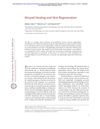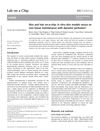TLDR Better understanding of wound healing is needed to develop effective treatments for chronic wounds.
The document reviewed the cellular mechanisms involved in wound healing, highlighting the complexity and dynamic nature of the process. It noted that disruptions in cellular behaviors, particularly in conditions like diabetes and aging, could lead to chronic, non-healing wounds, which posed a significant socioeconomic burden due to their prevalence and recurrence. The review emphasized the urgent need for a better biological and clinical understanding of wound repair mechanisms to develop effective therapies. It discussed both current knowledge and emerging insights into wound pathology that could guide future therapeutic advancements.
 65 citations
,
May 2017 in “Advances in wound care”
65 citations
,
May 2017 in “Advances in wound care” Toll-like receptors are important for wound healing, but can slow it down in diabetic wounds.
 359 citations
,
January 2015 in “Cold Spring Harbor Perspectives in Medicine”
359 citations
,
January 2015 in “Cold Spring Harbor Perspectives in Medicine” Hair growth phase and certain genes can speed up wound healing, while an inflammatory mediator can slow down new hair growth after a wound. Understanding these factors can improve tissue regeneration during wound healing.
 13 citations
,
December 2014 in “Stem Cells”
13 citations
,
December 2014 in “Stem Cells” Hair and skin can regenerate without bulge stem cells due to other compensating cells.
1235 citations
,
December 2013 in “Nature” Two fibroblast types shape skin structure and repair differently.
 208 citations
,
January 2013 in “Lab on a Chip”
208 citations
,
January 2013 in “Lab on a Chip” The Multi-Organ-Chip improves the growth and quality of skin and hair in the lab, potentially replacing animal testing.
 829 citations
,
May 2007 in “Nature”
829 citations
,
May 2007 in “Nature” Hair follicles can regrow in wounded adult mouse skin using a process like embryo development.
1279 citations
,
November 2005 in “Nature Medicine” 315 citations
,
June 2001 in “Nature Genetics”
1425 citations
,
September 2020 in “Open Biology” Better understanding of wound healing is needed to develop effective treatments for chronic wounds.




